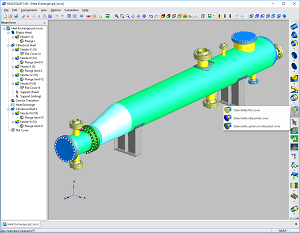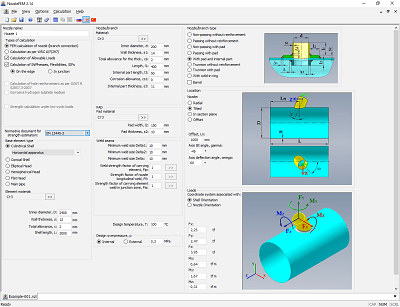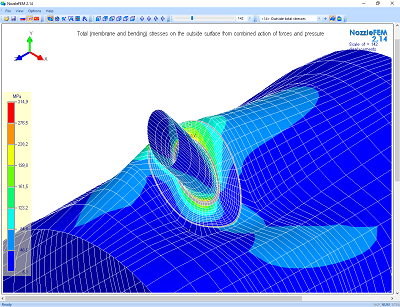
New employees can begin performing pressure vessel analysis in days rather than months!
Powerful capabilities
PASS/EQUIP provides comprehensive structural pressure vessels analysis.
PASS/EQUIP performs strength and stability calculation of horizontal, vertical, and column vessels, and takes into account wind and seismic loads. PASS/ EQUIP also calculates the strength and stability of shell and tube heat exchangers, including tubesheets, tubes, pass partitions, shells, expansion bellows, expansion boxes, and floating heads. The smart tube grid editor of heat exchanger provides very powerful opportunities of modeling non-standard tubesheets.
The program performs a calculation of strength and stability of horizontal and vertical pressure vessels for international codes. This calculation is based on GOST Standards, OST Standards, ASME Standards and European Standards.
PASS/EQUIP Nozzle-FEM provides analysis of nozzle-to-shell junctions using the Finite Element Method (FEM) including calculation of allowable nozzle loads and estimated nozzle junction strength for a wide range of geometric configurations and operating conditions. This includes arbitrary nozzle geometry connected to cylindrical and conical shells, as well as elliptic, hemispherical and flat heads and performs nozzle-shell junction flexibility calculations. The software automatically creates a finite mesh and performs stress analysis for nozzles (including trunnions) including shell membrane stress, bending stress, and total stress. Detailed nozzle analysis is recommended for the design and industrial safety review of oil and gas, refining, petrochemical, chemical, power plants and other industrial facilities.
System RequirementsWindows 7/8/10+x86-64 architecture processor1GB of RAMVideo card with OpenGL 2.0+ support and 1GB+ of RAM Display resolution at least 1024x768, recommended 1280x1024
Overview
PASS/EQUIP provides pressure vessel strength and stability analysis for horizontal and vertical vessels, columns, storage tanks, as well as shell, tube, and air cooled heat exchangers under static and seismic loads in order to evaluate bearing strength in operation, test, and assembly states. Applications include designing, revamping and testing of vessels, as well as making compliance calculations for power, oil-refining, chemical, petrochemical, natural gas, petroleum, and other related industries.
PASS/EQUIP also provides finite element analysis of arbitrary vessel nozzles for the purpose of estimating their stress, stiffness and allowable loads. The results can be automatically transferred to PASS/START-PROF to be used for piping stress analysis.
PASS/EQUIP combines sophisticated calculation capabilities and code compliance with ease-of-use to deliver simulation of pressure vessels for strength and stability by “regular” engineers and designers. Detailed calculation reports, produced by the program, contain comprehensive information (including all equations, intermediate results, and plot of forces and moments) and are ready to be delivered to any authorities or equipment certification body.
Equipment designers and process and piping engineers of more than 500 EPC and vessel manufacturing companies in Belarus, China, Czech Republic, Germany, India, Italy, Japan, Kazakhstan, Russia, South Korea, Ukraine and United States of America now use the software every day for design of different types of vessels, columns, tanks, heat exchangers, and nozzles..
Due to the large number of users and feedback from specialists in different branches of industry PASS/EQUIP continues to steadily evolve to meet modern demands. PASS/EQUIP is constantly verified and cross-test with similar programs.
Perform calculations in PASS/ EQUIP provides several benefits including: increased reliability and operational safety of equipment for various applications, improved the coordination of the project with regulatory authorities, and reduced costs and time.
PASS/EQUIP has a modern intuitive user interface, documentation and help system and our specialists provide application and technical support.
PASS/EQUIP provides the ultimate in usability by “regular” engineers allowing them to focus on equipment design. The user defines the equipment type, geometrical adjectives, material of the vessel components, type and allocation of supports, test type, and loading rates. Selection of vessel elements and materials is made from the vast databases, which can be updated by the user.
3D graphic display of equipment geometry is provided with the possibility of editing the color of separate elements or the whole model, with views to make it possible to see internal elements. Powerful 3D modeling opportunities also support export to various CAD formats, so the user could continue work on vessel design in his favorite CAD environment.
PASS/EQUIP does not require special training and can be used by any mechanical engineer.
Calculation of strength and stability of column type vessels, with wind loads and seismic effects is carried out using the PASS/EQUIP Columns module, based on GOST 34233.9, GOST 34283.
Calculation for strength and stability of shell, tube type and air cooled heat exchangers, is carried out by using the PASS/EQUIP-Vessel&Exchanger module based on GOST 34233.7, GOST 26-14-88, RD 30780-2002, and ASME VIII div. 1. The smart tube grid editor of PASS/EQUIP-Vessel&Exchanger provides very powerful modeling of non-standard tubesheets.
The calculation of the strength and stability of horizontal and vertical vessels, with loads from seismic effects is supported on the basis of STO-SA-03.003-2009, AzDYN 2/3-1, GOST R 55722 and GOST 34283.
Calculation of vertical steel cylindrical tanks is carried out using the PASS/EQUIP Tanks option on the basis of STO-SA-03-002-2011.
Calculation codes
- ASME VIII, div.1;
- EN 13445-3;
- GOST 34233.(1-12)-2017, GOST 34283-2017;
- GOST 14249-89, GOST 25221-82, GOST 26202-84, GOST 24755-89 etc;
- RD 26-15-88, RTM 26-01-96-77, RD 10-249-98, OST 26-01-64-83 etc.
Calculation codes
Databases
In order not to enter the necessary settings manually, there are a number of embedded databases:


PASS/EQUIP Nozzle-FEM
Nozzle-FEM is designed for stresses and flexibility calculation of nozzle-to-shell junctions using the Finite Element Method (FEM). The program also calculates nozzle’s allowable loads and estimates strength of the nozzle’s junctions for wide range of geometric configurations and operating conditions. Nozzle-FEM helps to provide higher level of the equipment safety along with reducing labour costs at the design stage. The program is recommended for designing and industrial safety review of oil and gas, refining, petrochemical, chemical, power and other industrial facilities.
Unlike the universal FEM programs (ANSYS, NASTRAN, COSMOS, etc.), this program does not require special training and can be used by any mechanical engineer. Creation of finite element mesh and estimation of calculation results are performed automatically. FEM calculation, as opposed to semi-analytic methods (i.e. WRC 107/297, GOST 34233.3-2007, etc.), expands the program application range and increases analysis accuracy.
The program performs stress analysis for nozzles (including trunnions) of arbitrary geometry connected to cylindrical and conical shells, as well as elliptic, hemispherical and flat heads. It takes into account vessel boundary restraints and loads on the nozzle from the adjacent pipeline. Both nozzle and shell membrane, bending and total stresses can be calculated. Calculation of the pipe branch connections is also implemented, enabling detailed stress analysis of non-standard tees and pipelines branch connections.
Along with stress and stability analysis the program also performs nozzle-shell junction flexibility calculation, as this flexibility can considerably influence vessel and piping stresses. During stress analysis of pipeline systems nozzle-vessel junctions are often simulated by anchor supports which leads to overestimation of stresses and tensions. In order to automatically create the appropriate non-standard support in the calculation model, the nozzle-shell junction flexibility calculated by Nozzle-FEM can be copied via the clipboard into the PASS/START-PROF piping stress analysis program.
Stress state can be estimated by different codes: ASME VIII div.1,2; EN 13445-3; GOST 34233.1-2007; JB 4732-1995; PNAE G-7-002-86 (for equipment and pipelines of nuclear power plants) for allowable stresses. Vessel stress and stability analysis (according to GOST 34233.2-2007) is also implemented, as well as reinforcement required of openings under internal pressure (GOST R 52857.3-2007). Nozzle-shell junctions working in corrosive hydrogen sulphide environment are analysed in accordance with GOST 34233.10-2007.
Besides finite element method calculation, the program supports CIF and flexibility calculation via semi-analytic methods according to WRC107-79, WRC297-87 (Welding Research Council Bulletins No. 107, No. 297 “Local stresses in spherical and cylindrical casings caused by the external loads”) and BS5500-76 (British standard).
The calculation results can be automatically reported in RTF.
Configurations PASS/EQUIP can be delivered in different configurations:
Configurations PASS/EQUIP can be delivered in different configurations:







